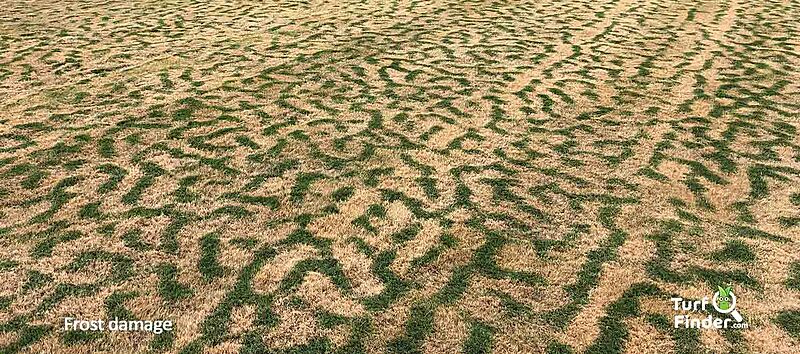The following turf management tips have been provided by Australian Sports Turf Consultants (ASTC) and Australian Lawn Fanatics #auslf.
Click on either of the seasonal turf care tabs below to find further information.
Watering is best in the morning. Avoid over watering as it can promote fungal disease in your thatch layer and may result in additional frost damage. Generally, this time of year your soil remains moist requiring less irrigation due to reduced (soil) temperatures. Read more on irrigation here...
Turf colourant provides a 100% organic and non-toxic alternative to improve turf colour. The turf colourant or pigment, which is green in colour, can be used year round and is frequently used during winter to change a brown dormant grass into a dark green lawn. It can also be use pre and post frost damage.
The photo shown below was taken of a hybrid bermudagrass turf variety in Canberra, ACT on 14 April 2020. Reduce your mowing height and provide an even turf surface, plus cutting height, to reduce a "zebra" pattern. If possible, a very early morning irrigation will also stop or reduce frost damage.

Once your thatch has been removed, or is under control, now it’s time to look at surface and subsoil compaction. Does water simply run off when it rains? Do you have high traffic areas from the kids or dog(s)? If your struggling from hard soil compaction and there is evidence of moss that appeared during winter, now is the perfect time to aerate. Coring or solid tine aeration is best performed by a machine. However, if you have the time and a pitchfork go for your life. Aeration will help with the transfer of oxygen and allow an easy path for nutrients to access the rootzone and aide water retention through the voids that have been formed during aerating.
Topdressing is just as important as any other step and in most cases the most important step in undertaking turf renovations. This is your chance to sort out any imperfections and or undulations in your lawn. What to use? Well that’s completely up to the individual and circumstances as some prefer organic material, some prefer sandy loam soil and some go straight out sand. By now you will have a fair understanding of your profile and what you need. The best is USGA sand that’s blended with soil amendments (fertiliser). A medium or medium to fine washed sand is also good as it should not contain weed seeds. However, washed sand contains no nutrient content. There are numerous benefits of topdressing with sand, including that it doesn’t compact and allows the water and nutrients to flow freely into the rootzone. The downside of a soil based topdress is you really don’t know what you’re going to get these days and it could well be full of weed seeds.
See our soil and sand page for further details and product options.
Don’t undo everything at this stage and forget the prevention of all those turf pests that tend to feed on our lawns through the growing season. The surface is open and access to your soil is at a premium after aeration. It is a good time to apply Acelepryn technology which comes in liquid or granular form. It is now also readily available in smaller quantities suitable for residential customers. The Acelepryn technology createa a residual barrier that does not allows new weed seed (refer to product label) to germinate. The insecticide can provide protection for up to 6 months. Prevention is better than cure.
Hopefully you gave your chariot (aka mower) a service during winter to ensure the blades and or reel are sharp. Regular mowing will increase turf density and maintain plant health. For those that used sand topdressing, a very light water before you mow will keep the sand from ending up in your catcher and or going through your reel. Visit our mowing page for further information and advice.
Watering is not something to be overlooked. The last thing you want after a renovation is it to dry out. Watering times will depend purely on your location and climate. Not one watering schedule fits all suburbs and lawns. You will find the longer and hotter the days the more you need to keep an eye on your lawn and make sure it has the required water and soil moisture. If the weather becomes dry and windy that can be just as bad as a heatwave. Make sure you maintain your watering regularly during recovery then you can possibly move to a deeper less frequent watering schedule. Remember that you can cause as much damage to your turf through over watering as you can under watering. Moisture meters are handy, but nothing beats the ole finger in the soil to feel it for yourself. Visit our irrigation and watering for further information and advice.
Decrease the frequency and amount of irrigation water being applied to the turfgrass following summer. Refer to our Turf Care Irrigation page, and click on 'How much water to apply?' for further information.
March is the final month during which lawn renovations should be carried out. This includes scarification and topdressing. However, aeration or decompaction work can be conducted year-round.
Lawn Solutions Rescue
5 (N) - 7 (P) - 2 (K) + Kelp 7.5%, Polyacrylamide (PAM) 7.5% and trace elements
Vitalnova Stressbuster
7 (N) - 0 (P) - 0 (K) + 2 (Fe), sugars, wetting agent, amino acids and trace elements
Yates Buffalo Pro Lawn Fertiliser
14 (N) - 2.5 (P) - 10 (K) + seaweed, humates and trace elements